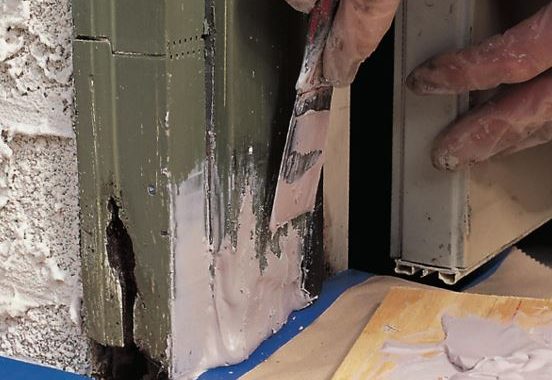Rebuild and restore rotted wood without replacing it.
Introduction
Use a polyester filler to rebuild rotted or damaged wood. You can mold and shape it to match the original wood profile. It takes paint well and won’t rot.
Tools Required
- Paintbrush
- Putty knife
- Rasp
- Sanding block
- Utility knife
- Wood chisel
Materials Required
- 100-grit sandpaper
- Polyester filler
- Wood hardener
Project step-by-step
Step 1: Repair wood with polyester filler: Apply wood hardener and filler
To repair a rotted door frame, first, remove rotted wood with a 5-in-1 or other sharp tool. Then coat the rotted door frame area with wood hardener. Mix polyester wood filler or Bondo wood filler and press it into the recess with a putty knife.
Step 2: Shape and smooth
Carve the partially hardened sagging Bondo wood filler with a putty knife or chisel. Add another layer of filler if necessary, to the rotted door frame.
If you’ve done any auto body repair, you’ve probably worked with two-part polyester filler. Minwax High-Performance Wood Filler is one brand formulated for wood repair, but a gallon container of Bondo wood filler or some other brand of two-part auto body polyester will also work and may be less expensive for larger fixes.
The process for repairing wood is much the same whether you’re using polyester filler or epoxy. Instead of epoxy, you’ll use High-Performance Wood Hardener to solidify and strengthen the wood fibers. Polyester begins hardening faster than epoxy. Depending on the temperature, you’ll have about 10 to 15 minutes to work before the filler starts to harden.
Step 3: Smooth out the repair
Also, unlike epoxy, polyester tends to sag when you’re doing vertical repairs. One trick is to build a form and line it with plastic sheeting. Press the form against the filler and attach it with screws. Then pull it off after the filler hardens. Or you can wait until the sagging filler reaches the hardness of soap and carve it off with a putty knife or chisel or shape it with a plane or rasp. Most medium to large repairs will require at least two layers of filler. Complete the repair by sanding and priming the filled area and then painting.


